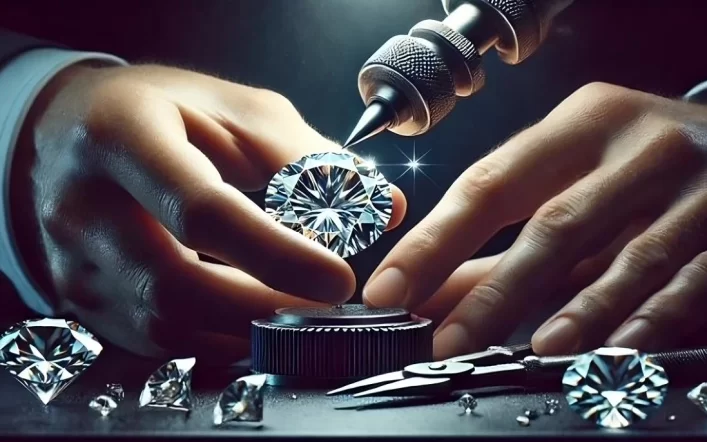Exploring the World of Ethical Lab-Grown Diamonds

1. Introduction
When it comes to selecting the perfect symbol of love or luxury, diamonds have always held a special place. However, the traditional diamond mining process raises ethical concerns regarding environmental impact, labor practices, and human rights violations. In recent years, the rise of ethical lab-grown diamonds has provided a sustainable and morally sound alternative for conscientious consumers.
2. What are Ethical Lab-Grown Diamonds?
Ethical lab-grown diamonds are precisely what the name suggests: diamonds cultivated in a laboratory setting rather than mined from the earth. These diamonds are created using advanced technological processes that replicate the natural conditions under which diamonds form, resulting in gemstones that are chemically, physically, and visually identical to their mined counterparts.
3. How are Ethical Lab Grown Diamonds Made?
The process of producing ethical lab grown diamonds involves two primary methods: High Pressure High Temperature (HPHT) and Chemical Vapor Deposition (CVD). In the HPHT method, a small diamond seed is placed under high pressure and temperature, man made diamonds, allowing carbon atoms to form around it, gradually creating a larger diamond. Conversely, CVD involves the deposition of carbon atoms onto a substrate, forming a diamond layer over time.
4. Advantages of Ethical Lab-Grown Diamonds
One of the most significant advantages of ethical lab grown diamonds lies in their environmental impact. Unlike traditional mining, which can result in deforestation, habitat destruction, and soil erosion, lab-grown diamonds require minimal land use and significantly reduce carbon emissions and water usage. Furthermore, the absence of mining eliminates the risk of human rights abuses and exploitation in diamond-producing regions.
5. Quality and Durability
Contrary to common misconceptions, ethical lab grown diamonds are indistinguishable from natural diamonds in terms of quality and durability. Both types of diamonds exhibit the same chemical composition and physical properties, including hardness and brilliance. As a result, lab-grown diamonds are equally suitable for use in jewelry and other applications.
6. Affordability
Another compelling reason to opt for ethical lab-grown diamonds is their affordability. While natural diamonds are subject to fluctuations in supply and demand, driving prices up, lab-grown diamonds offer a more stable and accessible alternative. Additionally, the controlled production process allows for greater predictability in pricing, making lab-grown diamonds a cost-effective choice for consumers.
7. Transparency and Traceability
One of the key benefits of ethical lab grown diamonds is the transparency and traceability of their supply chain. Unlike mined diamonds, which may pass through multiple hands before reaching the consumer, lab-grown diamonds can be traced back to their origin with precision. This transparency provides assurance to buyers regarding the ethical and environmental credentials of their purchase.
8. Consumer Awareness
As awareness of ethical and sustainability issues continues to grow, more consumers are actively seeking out alternatives to traditional mined diamonds. By educating themselves about the benefits of ethical lab grown diamonds, buyers can make informed choices that align with their values and contribute to positive social and environmental change.
9. Ethical Considerations
In addition to their environmental benefits, ethical lab grown diamonds also have positive implications for communities and workers involved in the diamond industry. By reducing the demand for mined diamonds, lab-grown diamonds help alleviate the social and economic pressures faced by communities in diamond-producing regions, fostering greater equity and stability.
10. Industry Regulation
To ensure the integrity of the ethical lab grown diamonds market, industry regulation and certification standards play a crucial role. Leading organizations such as the Gemological Institute of America (GIA) and the International Organization for Standardization (ISO) have developed guidelines and protocols for the grading and certification of lab-grown diamonds, providing consumers with confidence in their purchases.
11. Popular Brands and Suppliers
Several reputable brands and suppliers specialize in the production and sale of ethical lab-grown diamonds. Companies such as Ada Diamonds, Brilliant Earth, and MiaDonna are recognized for their commitment to sustainability, transparency, and ethical practices, offering a wide range of la grown diamond jewelry to suit diverse preferences and budgets.
12. Common Misconceptions
Despite the growing acceptance of lab grown diamonds, there are still some misconceptions surrounding their quality and value. One common myth is that lab-grown diamonds are inferior to natural diamonds, which is simply not true. Lab-grown diamonds undergo the same rigorous testing and certification processes as mined diamonds, ensuring their authenticity and quality.
13. Future Trends
As technology continues to advance, the future of ethical lab grown diamonds looks promising. Innovations in diamond synthesis techniques and increased scalability of production methods are driving down costs and expanding market accessibility. Furthermore, growing consumer demand for sustainable and ethically sourced products is fueling the growth of the lab-grown diamond industry.
Conclusion
In conclusion, ethical lab grown diamonds offer a sustainable, socially responsible, and morally sound alternative to traditional mined diamonds. With their identical quality, durability, and beauty, lab-grown diamonds provide consumers with a guilt-free option for celebrating life’s special moments while contributing to positive environmental and social impact.




